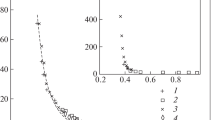Summary
A study of the thermogravitational behaviour of aqueous saline solutions containing macromolecular dextrans (2 000 000 a.m.u.) has led to the discovery of an inversion in the direction of flow of the macromolecular component in the thermal gradient, within a certain range of concentrations of the saline component of the solution. In these experiments the small molecular and the macromolecular components actually flow in opposite directions along the thermal gradient. This behaviour seems to contradict previous theories of thermal diffusion based on Brownian-motion models, while it is compatible with the radiation-pressure theory of this phenomenon. The variation of concentration of the saline component of the solution induces a conformational transformation in the macromolecules, thus altering their behaviour in the thermal gradient, to the point of reversing the direction of migration of the macromolecular component. Aside from its theoretical significance, this fact constitutes an extreme but meaningful demonstration of the sensitivity of thermodiffusive methods to the structure of macromolecular solutes and their transformation.
Riassunto
Lo studio del comportamento di soluzioni saline acquose contenenti destrani macromolecolari (2 000 000 u.a.m.) in un apparecchio termogravitazionale, ha portato alla scoperta di una inversione nella direzione del flusso del componente macromolecolare entro il gradiente termico, nel’ambito di un certo campo di concentrazione del componente salino della soluzione. In questi esperimenti si è trovato che nelle condizioni sopra citate la componente salina e quella macromolecolare fluiscono l’una in direzione opposta all’altra lungo il gradiente termico. Questo comportamento sembra contraddire le esistenti teorie della diffusione termica basata su modelli a moto-Browniano, mentre è compatibile con la teoria della pressione di radiazione termica recentemente avanzata per spiegare questo fenomeno. La variazione di concentrazione del sale nella soluzione induce nelle macromolecole una trasformazione conformazionale, ed in tal modo altera il loro comportamento in seno al gradiente termico fino al punto da invertirne la direzione di migrazione. A parte la sua importanza teorica, questo fatto costituisce una dimostrazione in un caso limite, ma significativo, della sensibilità dei metodi termodiffusivi alla struttura delle macromolecole ed alle loro trasformazioni conformazionali.
Реэюме
Исследование термо-гравитаци онного поведения водных соляных растворов, содержаших макромолекулы декстрина (2000000 a.m.u.), привело к открытию инверсии в направлении потока макромолекулярной компоненты при тепловом градиенте внутри некоторой области концентраций соляной компоненты раствора. В зтих зкспериментах компонента с малыми молекулами и макромо-лекулярная компонента фактически текут в противоположных направлениях вдоль теплового градиента. Кажется, что зто поведение противоречит предыдушим теориям тепловой диффуэии, основанным на моделях броуновского движения, хотя окаэывается согласуюшимся с теорией радиационного давления в зтом явлении. Иэменение концентрации соляной компоненты раствора индуцирует структурную трансформацию в макромолекулах, тем самым иэменяя их поведение при тепловом градиенте до такой степени, что меняется направление миграции макромолекулярной компоненты. Помимо теоретической эначимости, зтот зффект представляет чреэвычайную и важную иллюстрацию чувствительности термо-диффуэионных методов к структуре макромолекулярных растворов и их преобраэований.
Similar content being viewed by others
References
A. A. Emery jr. andH. G. Drickamer:Journ. Chem. Phys.,23, 2252 (1955).
P. Debye andA. M. Bueche:High-Polymer Physics (Brooklyn, 1948), p. 497.
G. Langhammer:Naturwiss.,41, 525 (1954).
G. Langhammer andK. Quitzsch:Macromolekulare Chemie,17, 74 (1955).
G. Langhammer:Koll. Zeits.,44, 146 (1956).
G. Langhammer:Journ. Chem. Phys.,54, 885 (1957).
F. C. Whitmore:Journ. Appl. Phys.,31, 1858 (1960).
F. S. Gaeta andN. M. Cursio:Rev. Polymer Sci., A-1,7, 1697 (1969).
S. Chapman:Phil. Mag.,5, 630 (1928).
S. Chapman:Phil. Mag.,7, 1 (1929).
J. S. Ham:Journ. Appl. Phys.,31, 1853 (1960).
A. W. Porter:Trans. Faraday Soc.,23, 314 (1927).
W. M. Rutherford andH. G. Drickamer:Journ. Chem. Phys.,22, 1157 (1954).
R. L. Saxton andH. G. Drickamer:Journ. Chem. Phys.,22, 1287 (1954).
E. L. Dougherty jr. andH. G. Drickamer:Journ. Chem. Phys.,23, 295 (1955).
R. J. Bearman, J. G. Kirkwood andM. Fixman:Adv. Chem. Phys.,1, 1 (1958).
E. Hefland andJ. G. Kirkwood:Journ. Chem. Phys.,32, 857 (1960).
F. S. Gaeta:Phys. Rev.,182, 289 (1969).
G. Nicolis:Journ. Chem. Phys.,43, 1110 (1965).
S. R. De Groot:L’effet Soret. Diffusion thermique dans les phases condensées (Amsterdam, 1945).
A. Gronwell:Dextran and Its Use in Colloidal Infusion Solutions (Stockholm, 1957).
H. S. Isbell et al.:Journ. Research Nat. Bur. Standards,50, 8 (1953).
I. Prigogine, L. De Brourkère andR. Amand:Physica,16, 577 (1950).
I. Prigogine, L. De Brourkère andR. Amand:Physica,16, 851 (1950).
Author information
Authors and Affiliations
Additional information
To speed up publication, the authors of this paper have agreed to not receive the proofs for correction.
Rights and permissions
About this article
Cite this article
Gaeta, F.S., Di Chiara, A. & Perna, G. Inversion in the direction of thermal-diffusion flow of dextran molecules in solution. Nuovo Cimento B (1965-1970) 66, 260–272 (1970). https://doi.org/10.1007/BF02710263
Received:
Published:
Issue Date:
DOI: https://doi.org/10.1007/BF02710263




